-
Welcome back Guest! Did you know you can mentor other members here at H-M? If not, please check out our Relaunch of Hobby Machinist Mentoring Program!
You are using an out of date browser. It may not display this or other websites correctly.
You should upgrade or use an alternative browser.
You should upgrade or use an alternative browser.
Round-nosed lathe tooling?
- Thread starter Harvey
- Start date
- Joined
- Oct 18, 2016
- Messages
- 2,872
Interesting. I've heard that too but I don't see a picture of that round HSS/carbide blank configuration on their website. Does the holder have a Vee notch & the rod gets clamped in there like the square bit? Happen to have a pic of that?
https://www.eccentricengineering.com.au/index.php?option=com_content&view=featured&Itemid=101
Also, just being picky - wouldn't the projected round section cut an ellipse due to the rod's back angle clearance & probably exaggerated a bit more with any positive rake on the upper surface?
The issue with any of these 'hold the cutter' type ideas (including mine) is that the cutting profile may well have penetrate half its diameter which means the supporting tool holder doesn't have very much meat to grab onto or support without interfering with the cut profile itself. Maybe one could braze the button on like a conventional turning tool, but now its getting even more complicated. A tool & cutter grinder would make an accurate radius shape with all the requisite relief geometry directly out of HSS blank, but not everyone has such a machine.
For larger grooves the weapon of choice is a Holdridge Radii principle, but I think the smallest arc is maybe .75" or so
The holder has V notches on two sides, so a round would be clamped between them.
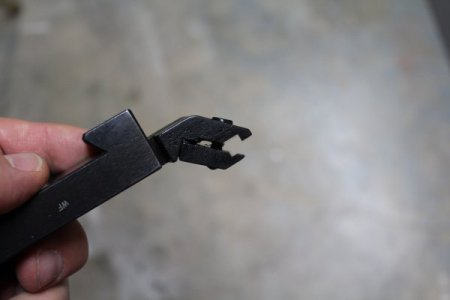
Not sure, but I don't think it would cut an ellipse because the OD of the rod is still a circle (looking down along it's axis). Also, the tool is presented
to the work at an angle which cancels out some of the angle ground into the tool. But, you're right, there is a limit to how far into the
material the tool could cut before interference with the holder. That depends to some degree on how far out of the holder the tool
is extended, as well as the diameter of the tool. But after all, these holders probably weren't really designed for serious profiling: the fact that
they can be used that way is just a bit of a bonus. I suspect that chatter would be a limiting factor, at least in the smaller
size tools.
What is Holdridge Radii principle?
Holdridge has produced a lathe accessory for many years. I just called it that because some people are familiar with the brand name. There are several home-brew versions. I guess a better description would be radius cutting principle. If the cutting bit is inside the swing axis, it cuts a ball/spherical shape on spinning stock. If the bit is outside the swing axis, it cuts an internal circular groove. Those are the highlighted skinnier cylindrical looking tool holders in pic.
http://www.holdridgemfg.com/
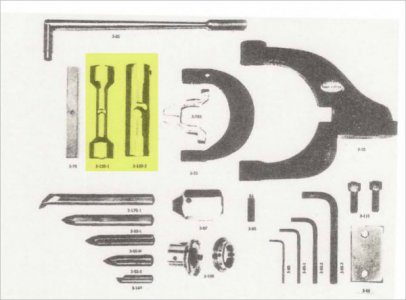
http://www.holdridgemfg.com/

Not sure, but I don't think it would cut an ellipse because the OD of the rod is still a circle (looking down along it's axis). Also, the tool is presented
to the work at an angle which cancels out some of the angle ground into the tool.
The way I see it, if the circular section cutting tool rod is positioned at an angle in the toolholder like post#29 pic to provide back clearance & fed into the work on the spindle rotation axis, that is equivalent to cutting a section across a cylinder & looking down on it from that cut plane...which yields an ellipse. This shows an example 15-deg angle & resultant effect on dimensions. To help visualize consider if the tool angle was greatly exaggerated like at 45 deg and now cut across the horizontal plane. The width would always equal the tool diameter but the profile would not be semi-circular, it grows into a longer aspect ratio elipse. And I suspect positive rake exaggerates this even more. Whether this is dimensionally significant or not is up to the machinist. Probably not on small diameter grooves. I'm just pointing out the geometry.
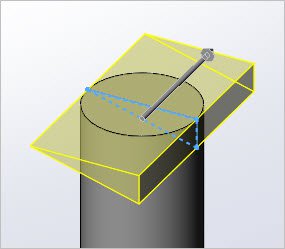
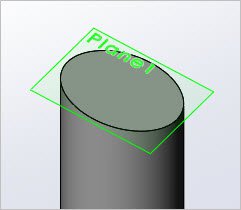
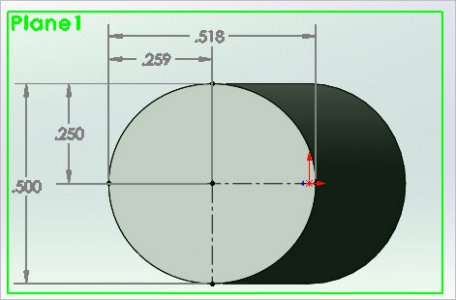
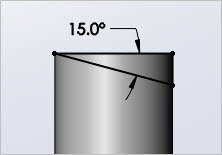
to the work at an angle which cancels out some of the angle ground into the tool.
The way I see it, if the circular section cutting tool rod is positioned at an angle in the toolholder like post#29 pic to provide back clearance & fed into the work on the spindle rotation axis, that is equivalent to cutting a section across a cylinder & looking down on it from that cut plane...which yields an ellipse. This shows an example 15-deg angle & resultant effect on dimensions. To help visualize consider if the tool angle was greatly exaggerated like at 45 deg and now cut across the horizontal plane. The width would always equal the tool diameter but the profile would not be semi-circular, it grows into a longer aspect ratio elipse. And I suspect positive rake exaggerates this even more. Whether this is dimensionally significant or not is up to the machinist. Probably not on small diameter grooves. I'm just pointing out the geometry.




Form tooling needs a very rigid setup to work well (for example braze-on radii cutters). Your small radii cutter idea is fantastic! Really nice Work!
Thank you.
I suspect another issue is the flame brazing temperature relative to hardened O1 might be hot enough to re-anneal it. Carbides survive the heat but that does us no good if we cant make a carbide profile. Silver soldering? Sounds like a PITA. You see this is why I mentally justify a tool & cutter grinder! LOL
Thank you.
I suspect another issue is the flame brazing temperature relative to hardened O1 might be hot enough to re-anneal it. Carbides survive the heat but that does us no good if we cant make a carbide profile. Silver soldering? Sounds like a PITA. You see this is why I mentally justify a tool & cutter grinder! LOL
- Joined
- Oct 11, 2016
- Messages
- 3,857
And a very nice one your tool and die grinder is! I've made some form tools using silver soldered carbide, and they work well. I get some chatter when the cutting area gets pretty wide, but I clean that up with wet and dry...
- Nothing like the accuracy required for your valves, for instance....
- Nothing like the accuracy required for your valves, for instance....
- Joined
- Apr 23, 2013
- Messages
- 1,004
Pic of tool and steel bar.https://photos.app.goo.gl/ct54fraDnrXSPo9L9
This is a pic showing what a full .312 wide radius hand ground tool looks like and what the steel bar looks like with the groove formed in it. Took about 1/2 hour to make using a 11 inch Logan to do it.
This is a pic showing what a full .312 wide radius hand ground tool looks like and what the steel bar looks like with the groove formed in it. Took about 1/2 hour to make using a 11 inch Logan to do it.
Last edited:
- Joined
- Oct 18, 2016
- Messages
- 2,872
Not sure, but I don't think it would cut an ellipse because the OD of the rod is still a circle (looking down along it's axis). Also, the tool is presented
to the work at an angle which cancels out some of the angle ground into the tool.
The way I see it, if the circular section cutting tool rod is positioned at an angle in the toolholder like post#29 pic to provide back clearance & fed into the work on the spindle rotation axis, that is equivalent to cutting a section across a cylinder & looking down on it from that cut plane...which yields an ellipse. This shows an example 15-deg angle & resultant effect on dimensions. To help visualize consider if the tool angle was greatly exaggerated like at 45 deg and now cut across the horizontal plane. The width would always equal the tool diameter but the profile would not be semi-circular, it grows into a longer aspect ratio elipse. And I suspect positive rake exaggerates this even more. Whether this is dimensionally significant or not is up to the machinist. Probably not on small diameter grooves. I'm just pointing out the geometry.
I see what you mean, though as you say, probably not all that significant. Any one that plans on an accurate profile would
pick a different tool I imagine.
- Joined
- Dec 3, 2014
- Messages
- 778
I certainly don't have that kind of experience in the trade but I do have an interest in HSS tool grinding. It has been sort of a pet focus for me for the last 30 years but I grant that I am not in a production environment. Still, I've ground a bunch of form tools over the years and have found that 12 degrees works well on a round nose tool like this (as opposed to the 8-10 degrees that is normally recommended). If the nose radius was narrower, I would increase the relief angles to 15 degrees to lower cutting forces even more to reduce chatter potential and improve finishes.
As I said, a matter of opinion.
I am with Mike on this. In my time grinding form tools from HSS or hi carbon steel blanks I like 10 to 15 degrees relief. Lowers cutting forces, reduces chatter in my experience. If I had 20 hp, flood coolant I might think different but for home shop size lathes like my 10EE going with more relief makes life easier.
- Joined
- Oct 18, 2016
- Messages
- 2,872
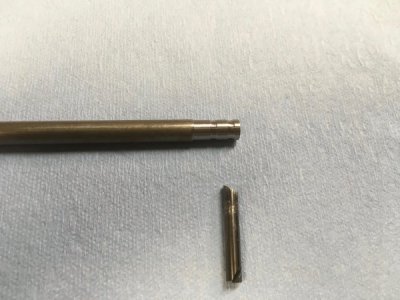
As a follow up to this post, I decided that I would try the diamond tool holder with round piece of HSS and see what results
I could get. The tool was an old drill bit of unknown quality (probably Chinesium) with piece of mystery steel round bar.
Eccentric Engineering suggested using the same jig they supply for grinding square tools, so I did that. The jig grinds
a lot of rake into the tool, but the tool holder is angled and cancels that out some. The best measurement I could take showed
a net rake of 13 degrees.
An initial cut with a regular lathe tool showed that the steel machined easily. The first pass with the round tool produced
chatter, but slowing the spindle speed fixed it. I was able to cut some grooves pretty easily by rotating the tool so that it
produce a slight shearing cut, but beyond a certain depth the feed force required increased and cutting pretty much stopped.
I also had problems with the cutting edge breaking down fairly quickly. I imagine a better piece of tool steel and a bit less
rake might have helped with that. Rotating the tool in the holder so that it was "square" to the work (no shearing) didn't
work at all.
So, with a better tool and some more experimenting I think this could be made to work, though not for deep or accurate
grooves.

